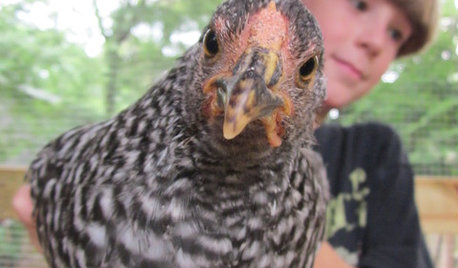Newbie with possible blight??
bedrichards86
12 years ago
Related Stories

HEALTHY HOMESleep Happier and Healthier in a Toxin-Free Bedroom
Light pollution, toxic bedding, wallpaper that off-gases ... if you're not getting good sleep, these bedroom blights might be to blame
Full Story
FARM YOUR YARD6 Things to Know Before You Start Growing Your Own Food
It takes time and practice, but growing edibles in the suburbs or city is possible with smart prep and patience
Full Story
BATHROOM DESIGN5 Small Bathrooms That Stretch Design Imagination
See how bathroom designers expanded the possibilities with fearless patterns, joyful accessories and smart space-saving solutions
Full Story
DECORATING GUIDESUncover Your Junk's Hidden Decorating Potential — Scads of DIY Ideas
Release your typewriter's inner planter or a drum set's coffee table. These creative ideas will have you seeing the possibilities
Full Story
EDIBLE GARDENSHow to Grow Your Own Luscious Cherries
Nope, they’re not the easiest fruit to grow. But with spectacular blossoms and pies as possibilities, cherries are sure worth a try
Full Story
KITCHEN DESIGNKitchen of the Week: Chestnut and an Open Fire in Connecticut
Antique chestnut boards give a kitchen with a wood-burning oven vintage flair, balancing its modern amenities
Full Story
FARM YOUR YARD4 Farm-Fresh Chicken Coops in Urban Backyards
These Atlanta henhouses are worth crowing about for their charming, practical designs
Full Story
FURNITURESmart Shopper: How to Judge Antique Furniture Quality
Pick the treasures from the trash without expert experience by learning how to evaluate antiques and what questions to ask
Full Story
ECLECTIC HOMESHouzz Tour: Wild Ideas in the Windy City
When bold art meets great architecture and interior design, something wonderful happens
Full StorySponsored
More Discussions







dickiefickle
missingtheobvious
Related Professionals
Allen Landscape Architects & Landscape Designers · Clark Landscape Contractors · Dallas Landscape Contractors · Mendota Heights Landscape Contractors · Miller Place Landscape Contractors · Corsicana General Contractors · Mount Vernon General Contractors · Rocky Point General Contractors · Troutdale General Contractors · Boise Decks, Patios & Outdoor Enclosures · Del Aire Decks, Patios & Outdoor Enclosures · Larkspur Decks, Patios & Outdoor Enclosures · Lewisville Decks, Patios & Outdoor Enclosures · Pataskala Decks, Patios & Outdoor Enclosures · Royal Oak Decks, Patios & Outdoor Enclosuresterrybull
carolyn137
behlgarden
garf_gw
yumtomatoes
missingtheobvious
carolyn137
jean001a